经典:宋词发展介绍【英文】
- 格式:ppt
- 大小:2.87 MB
- 文档页数:22
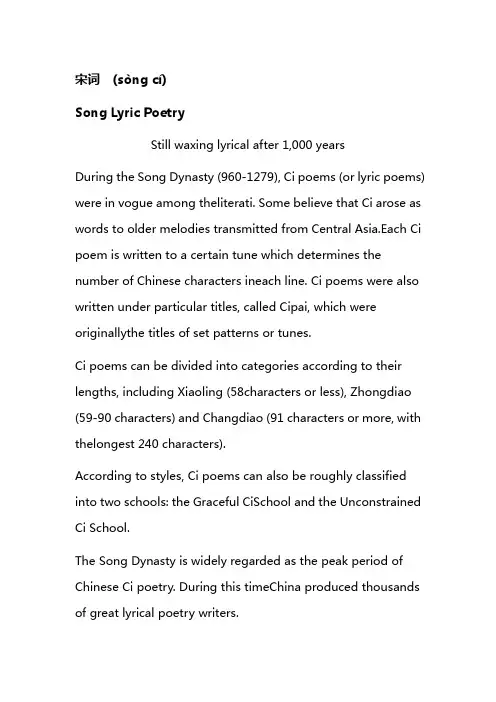
宋词(sòng cí)Song Lyric PoetryStill waxing lyrical after 1,000 yearsDuring the Song Dynasty (960-1279), Ci poems (or lyric poems) were in vogue among theliterati. Some believe that Ci arose as words to older melodies transmitted from Central Asia.Each Ci poem is written to a certain tune which determines the number of Chinese characters ineach line. Ci poems were also written under particular titles, called Cipai, which were originallythe titles of set patterns or tunes.Ci poems can be divided into categories according to their lengths, including Xiaoling (58characters or less), Zhongdiao (59-90 characters) and Changdiao (91 characters or more, with thelongest 240 characters).According to styles, Ci poems can also be roughly classified into two schools: the Graceful CiSchool and the Unconstrained Ci School.The Song Dynasty is widely regarded as the peak period of Chinese Ci poetry. During this timeChina produced thousands of great lyrical poetry writers.The “Complete Song Lyric Poetry,”published in 2009, contains nearly 20,000 Ci poems writtenby more than 1,330 Song poets.Among those are poets still popular today. Su Shi (1037-1101), also known by his pseudonym SuDongpo, played a crucial role in creating the style of expressive Ci poetry, combining descriptionsof natural phenomena with deep emotions and political ideas.Many of Su's more than 2,300 Ci poems remain so well known today that nearly every schoolstudent in the country can recite a few lines.These include the first two lines of his poem “Battle of Red Cliff.”“The Great River flows to the east,Washing into oblivion all gallant heroesof bygone years.”His lines describing the beautiful West Lake in the scenic city Hangzhou, the capital of ZhejiangProvince in eastern China are also still famous:“People tend to liken the West Laketo the Lady of the West,Plainly dressed or gorgeously adorned,She always looks the best.”The Lady of the West refers to one of the most famous beauties in ancient China.Among other Song Ci poets who remain very popular today are Liu Yong, Ouyang Xiu, HuangTingjian, Xin Qiji and Li Qingzhao.Xin Qiji (1140-1207) is widely considered one of the greatest writers of Ci poetry during theSouthern Song Dynasty(1127-1279), with many saying he was as talented as Su.Xin was also the chief representative of the unconstrained style, the first to introduce bothcolloquial and classical terms that rendered verse more like prose.Today, more than 600 poems by Xin have been preserved. Many are about his experience as amilitary leader fighting tribal invaders and others about his personal life and feelings. One of Xin's notable Ci poems is “The Lantern Festival to the Tune of Green Jade Bowl,”its lastthree lines the most famous: “In the crowd, I have looked for her morethan a thousand times,Then, suddenly, as I turn my head, I spot her,Over there, where lights are few and dim.”Li Qingzhao (1084-1155) is known as the finest female writer of Ci poetry in the history ofChinese literature.Li developed a distinctive graceful style of lyrical poetry which features plain language, a delicaterestraint, the blending of intense passion and literary images, and beautiful melodious rhythms.Li's poems are very easy to recite.One of her most famous lyrical poems is the “Double Ninth Festival,”to the tune of“Intoxicated Under the Shadow of Flowers.”And most critics agree the last three lines of thispoem are the most appealing:“Oh, no one will say that it's not endearing,When the west wind unfurls the curtain,I feel that I have become more emaciatedthan the yellow flower.”Today, many Chinese people still love Ci poems. For instance, late Chinese leader Chairman Maowas known as a great lover and writer of the genre, who has also left behind a number of verypopular Ci poems.。
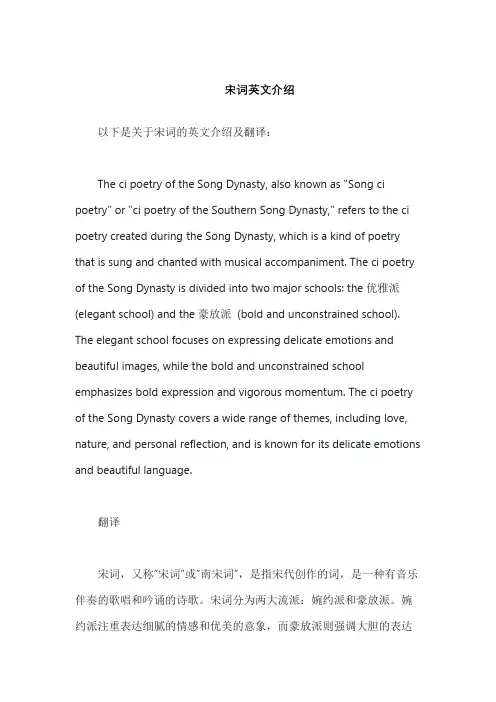
宋词英文介绍以下是关于宋词的英文介绍及翻译:The ci poetry of the Song Dynasty, also known as "Song ci poetry" or "ci poetry of the Southern Song Dynasty," refers to the ci poetry created during the Song Dynasty, which is a kind of poetry that is sung and chanted with musical accompaniment. The ci poetry of the Song Dynasty is divided into two major schools: the优雅派(elegant school) and the豪放派(bold and unconstrained school). The elegant school focuses on expressing delicate emotions and beautiful images, while the bold and unconstrained school emphasizes bold expression and vigorous momentum. The ci poetry of the Song Dynasty covers a wide range of themes, including love, nature, and personal reflection, and is known for its delicate emotions and beautiful language.翻译宋词,又称“宋词”或“南宋词”,是指宋代创作的词,是一种有音乐伴奏的歌唱和吟诵的诗歌。
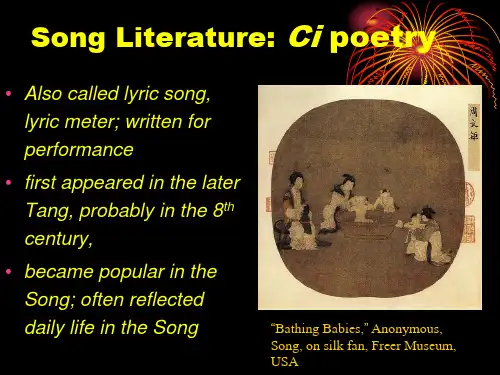
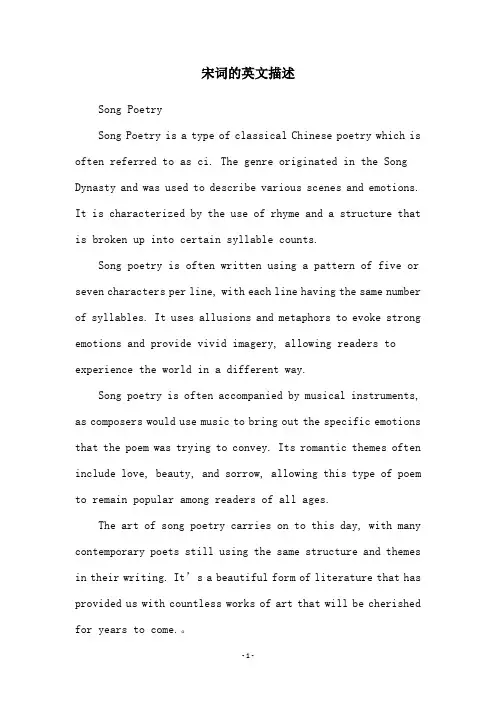
宋词的英文描述Song PoetrySong Poetry is a type of classical Chinese poetry which is often referred to as ci. The genre originated in the Song Dynasty and was used to describe various scenes and emotions. It is characterized by the use of rhyme and a structure that is broken up into certain syllable counts.Song poetry is often written using a pattern of five or seven characters per line, with each line having the same number of syllables. It uses allusions and metaphors to evoke strong emotions and provide vivid imagery, allowing readers to experience the world in a different way.Song poetry is often accompanied by musical instruments, as composers would use music to bring out the specific emotions that the poem was trying to convey. Its romantic themes often include love, beauty, and sorrow, allowing this type of poem to remain popular among readers of all ages.The art of song poetry carries on to this day, with many contemporary poets still using the same structure and themes in their writing. It’s a beautiful form of literature that has provided us with countless works of art that will be cherished for years to come.。
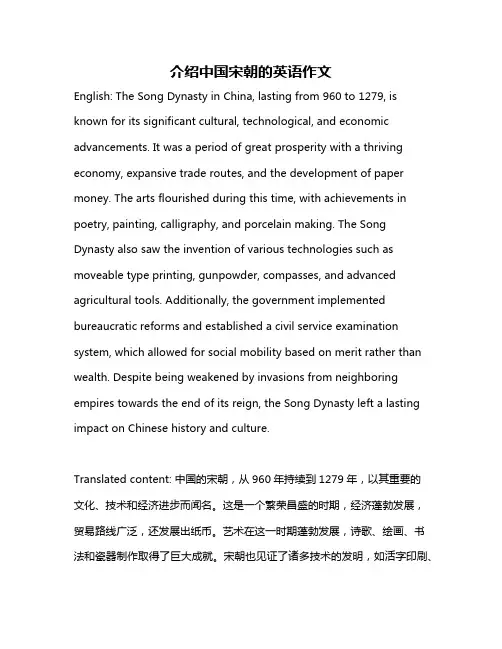
介绍中国宋朝的英语作文English: The Song Dynasty in China, lasting from 960 to 1279, is known for its significant cultural, technological, and economic advancements. It was a period of great prosperity with a thriving economy, expansive trade routes, and the development of paper money. The arts flourished during this time, with achievements in poetry, painting, calligraphy, and porcelain making. The Song Dynasty also saw the invention of various technologies such as moveable type printing, gunpowder, compasses, and advanced agricultural tools. Additionally, the government implemented bureaucratic reforms and established a civil service examination system, which allowed for social mobility based on merit rather than wealth. Despite being weakened by invasions from neighboring empires towards the end of its reign, the Song Dynasty left a lasting impact on Chinese history and culture.Translated content: 中国的宋朝,从960年持续到1279年,以其重要的文化、技术和经济进步而闻名。
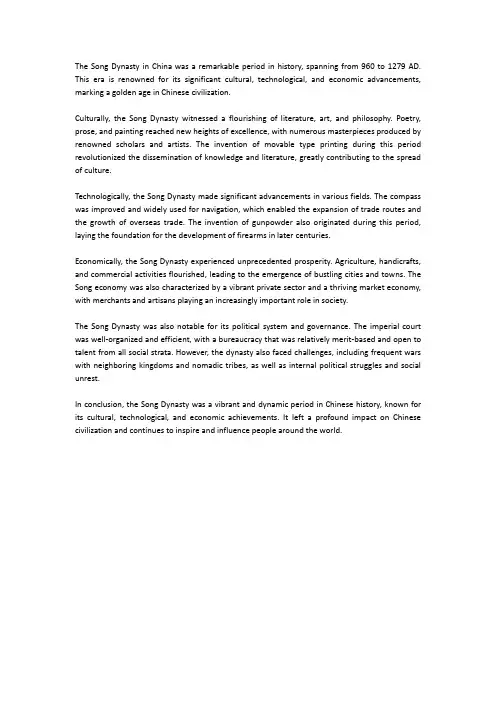
The Song Dynasty in China was a remarkable period in history, spanning from 960 to 1279 AD. This era is renowned for its significant cultural, technological, and economic advancements, marking a golden age in Chinese civilization.Culturally, the Song Dynasty witnessed a flourishing of literature, art, and philosophy. Poetry, prose, and painting reached new heights of excellence, with numerous masterpieces produced by renowned scholars and artists. The invention of movable type printing during this period revolutionized the dissemination of knowledge and literature, greatly contributing to the spread of culture.Technologically, the Song Dynasty made significant advancements in various fields. The compass was improved and widely used for navigation, which enabled the expansion of trade routes and the growth of overseas trade. The invention of gunpowder also originated during this period, laying the foundation for the development of firearms in later centuries.Economically, the Song Dynasty experienced unprecedented prosperity. Agriculture, handicrafts, and commercial activities flourished, leading to the emergence of bustling cities and towns. The Song economy was also characterized by a vibrant private sector and a thriving market economy, with merchants and artisans playing an increasingly important role in society.The Song Dynasty was also notable for its political system and governance. The imperial court was well-organized and efficient, with a bureaucracy that was relatively merit-based and open to talent from all social strata. However, the dynasty also faced challenges, including frequent wars with neighboring kingdoms and nomadic tribes, as well as internal political struggles and social unrest.In conclusion, the Song Dynasty was a vibrant and dynamic period in Chinese history, known for its cultural, technological, and economic achievements. It left a profound impact on Chinese civilization and continues to inspire and influence people around the world.。
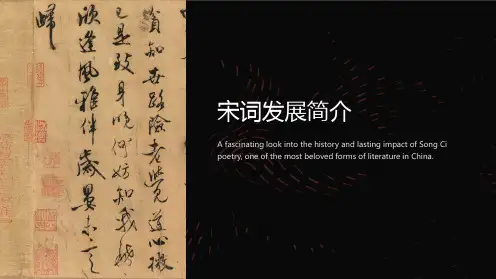
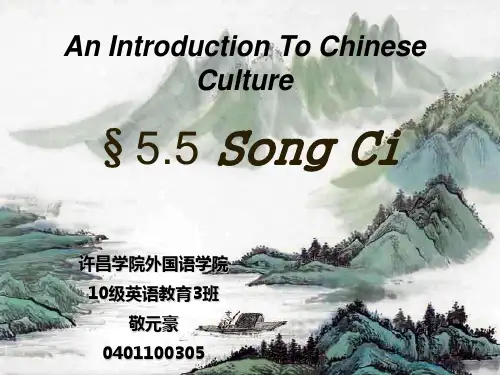
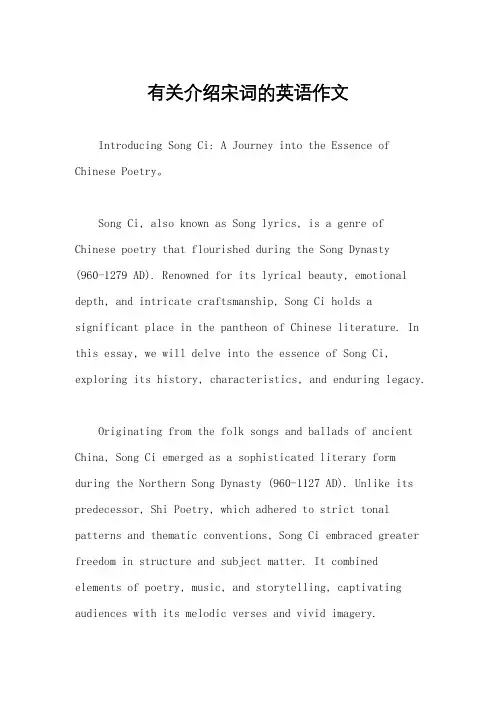
有关介绍宋词的英语作文Introducing Song Ci: A Journey into the Essence of Chinese Poetry。
Song Ci, also known as Song lyrics, is a genre of Chinese poetry that flourished during the Song Dynasty(960-1279 AD). Renowned for its lyrical beauty, emotional depth, and intricate craftsmanship, Song Ci holds a significant place in the pantheon of Chinese literature. In this essay, we will delve into the essence of Song Ci, exploring its history, characteristics, and enduring legacy.Originating from the folk songs and ballads of ancient China, Song Ci emerged as a sophisticated literary form during the Northern Song Dynasty (960-1127 AD). Unlike its predecessor, Shi Poetry, which adhered to strict tonal patterns and thematic conventions, Song Ci embraced greater freedom in structure and subject matter. It combined elements of poetry, music, and storytelling, captivating audiences with its melodic verses and vivid imagery.One of the distinguishing features of Song Ci is its emphasis on personal experience and emotion. Poets drew inspiration from everyday life, expressing love, longing, joy, sorrow, and other human sentiments with poignant sincerity. Through evocative language and subtle metaphors, Song Ci captured the fleeting moments of existence, immortalizing them in verse for future generations to cherish.Another hallmark of Song Ci is its meticulous attention to form and technique. Poets employed a wide range of literary devices, such as parallelism, alliteration, and symbolism, to enhance the beauty and complexity of their compositions. Each word was carefully chosen, each line meticulously crafted, to evoke a specific mood or atmosphere. Moreover, Song Ci often featured intricate rhyme schemes and tonal patterns, showcasing the virtuosity of its creators.Furthermore, Song Ci reflects the cultural diversity and cosmopolitanism of the Song Dynasty. As China's economythrived and its borders expanded, the empire became a melting pot of ethnicities, religions, and artistic traditions. This cultural exchange enriched the literary landscape, influencing the themes, styles, and techniques of Song Ci. Poets drew inspiration from Buddhist sutras, Taoist philosophy, Confucian ethics, and the folk traditions of various ethnic groups, weaving them into the fabric of their verses.Despite its historical origins, Song Ci remains relevant in contemporary Chinese literature and culture. Its timeless themes of love, nature, and the human condition continue to resonate with readers around the world. Moreover, Song Ci has inspired countless poets, writers, and musicians to explore new creative possibilities, bridging the gap between tradition and innovation.In conclusion, Song Ci represents the pinnacle of Chinese poetic artistry, blending musicality, emotion, and craftsmanship into a harmonious whole. Its rich legacy endures as a testament to the enduring power of languageand the human spirit. Through the timeless beauty of Song Ci, we gain insight into the essence of Chinese culture and the universal truths of the human experience.。
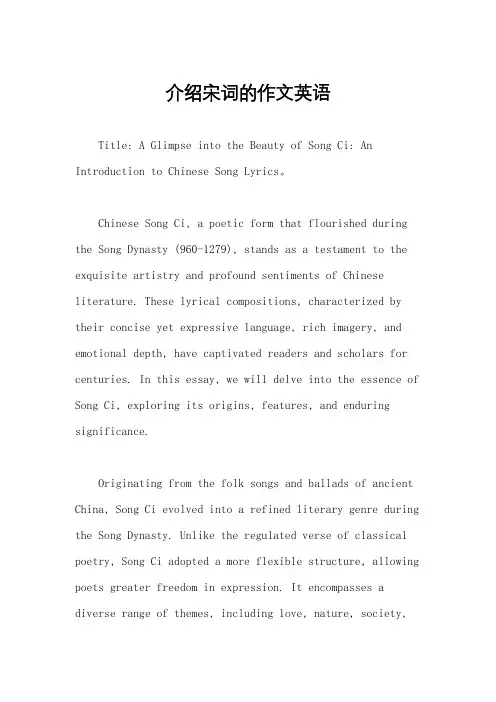
介绍宋词的作文英语Title: A Glimpse into the Beauty of Song Ci: An Introduction to Chinese Song Lyrics。
Chinese Song Ci, a poetic form that flourished during the Song Dynasty (960-1279), stands as a testament to the exquisite artistry and profound sentiments of Chinese literature. These lyrical compositions, characterized by their concise yet expressive language, rich imagery, and emotional depth, have captivated readers and scholars for centuries. In this essay, we will delve into the essence of Song Ci, exploring its origins, features, and enduring significance.Originating from the folk songs and ballads of ancient China, Song Ci evolved into a refined literary genre during the Song Dynasty. Unlike the regulated verse of classical poetry, Song Ci adopted a more flexible structure, allowing poets greater freedom in expression. It encompasses a diverse range of themes, including love, nature, society,and personal reflections, reflecting the myriad experiences and emotions of human existence.One of the defining features of Song Ci is its emphasis on vivid imagery and sensory appeal. Poets skillfully employ descriptive language and metaphors to evoke powerful emotions and create immersive experiences for the reader. Through carefully chosen words and phrases, they paint vibrant scenes of nature, depict fleeting moments of love and longing, or illuminate the complexities of the human condition.Moreover, Song Ci often integrates elements of music and performance, reflecting its origins in oral tradition. The rhythmic cadence of the verses, coupled with melodic tonal patterns, lends a musical quality to the poetry, enhancing its emotional resonance. Many Song Ci were composed to be sung or accompanied by musical instruments, further enriching the sensory experience for the audience.In addition to its aesthetic appeal, Song Ci also serves as a valuable historical and cultural record.Through the themes and motifs explored in these poems, we gain insights into the social norms, values, and traditions of the Song Dynasty period. Poets often drew inspiration from contemporary events, folklore, and philosophical teachings, infusing their works with layers of meaning and symbolism.Furthermore, Song Ci has had a profound influence on Chinese literature and culture, shaping subsequent generations of poets and artists. Its enduring popularity can be attributed to its timeless themes, universal truths, and emotive power, which continue to resonate with audiences across cultures and generations.In conclusion, Song Ci represents a pinnacle ofartistic achievement in Chinese literature, embodying the beauty, complexity, and depth of human experience. Through its lyrical verses, it invites us to contemplate the beauty of nature, the intricacies of love, and the mysteries of existence. As we immerse ourselves in the world of Song Ci, we embark on a journey of discovery and enlightenment, guided by the timeless wisdom of these poetic masterpieces.。
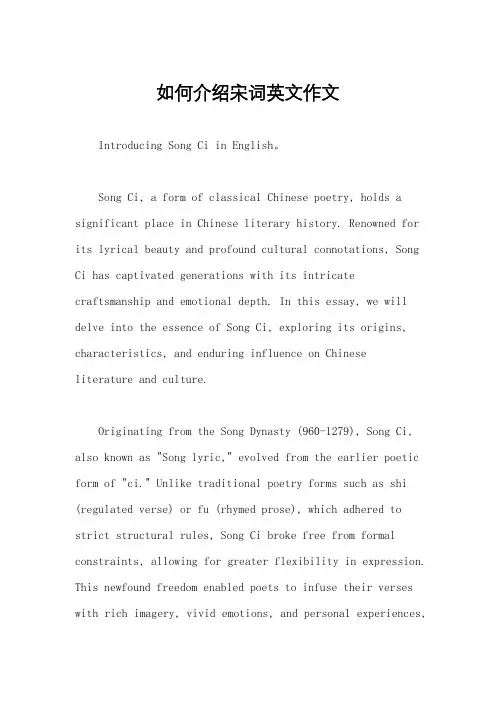
如何介绍宋词英文作文Introducing Song Ci in English。
Song Ci, a form of classical Chinese poetry, holds a significant place in Chinese literary history. Renowned for its lyrical beauty and profound cultural connotations, Song Ci has captivated generations with its intricate craftsmanship and emotional depth. In this essay, we will delve into the essence of Song Ci, exploring its origins, characteristics, and enduring influence on Chineseliterature and culture.Originating from the Song Dynasty (960-1279), Song Ci, also known as "Song lyric," evolved from the earlier poetic form of "ci." Unlike traditional poetry forms such as shi (regulated verse) or fu (rhymed prose), which adhered to strict structural rules, Song Ci broke free from formal constraints, allowing for greater flexibility in expression. This newfound freedom enabled poets to infuse their verses with rich imagery, vivid emotions, and personal experiences,thus forging a deep connection with readers.One of the distinctive features of Song Ci lies in its musicality. Inspired by folk tunes and melodies, Song Ci often incorporates rhythmic patterns and tonal variations, creating a harmonious blend of words and sounds. This melodic quality not only enhances the aesthetic appeal of the poetry but also serves as a testament to the close relationship between poetry and music in traditional Chinese culture.Another hallmark of Song Ci is its thematic diversity. While some poems celebrate the beauty of nature or express tender emotions, others delve into the complexities of human relationships or reflect on the transience of life. Through a wide range of subjects and motifs, Song Ci captures the myriad facets of human experience, offering profound insights into the human condition.Moreover, Song Ci is renowned for its intricate use of language and symbolism. Poets often employ literary devices such as metaphor, allegory, and allusion to convey deepermeanings and evoke subtle emotions. By layering multiple interpretations within their verses, Song Ci poets invite readers to embark on a journey of exploration and discovery, uncovering hidden truths beneath the surface of words.The enduring legacy of Song Ci extends far beyond the realm of literature. As a cultural treasure of ancient China, Song Ci has left an indelible mark on various art forms, including painting, calligraphy, and music. Artists and scholars throughout history have drawn inspiration from Song Ci, incorporating its themes and motifs into their creative works, thus ensuring its continued relevance and resonance in Chinese society.In conclusion, Song Ci stands as a testament to the enduring power of poetry to transcend time and space, touching the hearts and minds of readers across generations. With its lyrical beauty, thematic richness, and cultural significance, Song Ci continues to enchant and inspire audiences around the world, cementing its rightful place as a literary masterpiece of the Chinese civilization.。
英语作文我眼中的宋词英文回答:The Song dynasty (960-1279), a period of unparalleled prosperity and cultural achievements in Chinese history,left an enduring legacy in the form of ci poetry, or Song ci. These lyrical and often evocative poems have captivated generations of readers with their exquisite craftsmanship, vivid imagery, and profound emotional depth.One of the hallmarks of Song ci is its tonal complexity. Unlike shi poetry, which adhered to strict metrical andtonal patterns, ci allowed for greater freedom in rhyme and rhythm. This flexibility enabled poets to express a wide range of emotions, from the melancholic and reflective to the exuberant and celebratory.Another defining feature of Song ci is its use of imagery. Poets often drew inspiration from everyday life, depicting the changing seasons, the beauty of nature, andthe joys and sorrows of human existence. Through vivid and evocative imagery, they created a rich and immersive world that transported readers beyond the confines of their own experiences.The emotional depth of Song ci is perhaps its most striking characteristic. Poets poured their hearts and souls into these verses, exploring themes of love, loss, longing, and nostalgia. Their words resonate with a universal human experience, connecting readers with the timeless emotions of the human condition.The form of Song ci evolved over time, with different subgenres emerging to meet the changing needs and tastes of the era. Early ci were primarily associated with the court and the educated elite. However, as the dynasty progressed, ci became more popular among the broader populace. This led to the development of new styles, such as the graceful and elegant "slow ci" and the lively and upbeat "fast ci."The legacy of Song ci extends far beyond the boundaries of its time. Its influence can be seen in later Chineseliterature, music, and even painting. The poems have been translated into numerous languages, introducing the beauty and sophistication of Chinese culture to readers worldwide.中文回答:在我的眼中,宋词是一幅幅流淌在时光长河中的瑰丽画卷,承载着中华民族的千年风华与情感脉动。
关于宋词的英文作文英文回答:The Song dynasty was a golden age for Chineseliterature, producing some of the most enduring and influential works of poetry. Song ci, a lyrical form of poetry that flourished during this period, is renowned for its exquisite imagery, evocative language, andsophisticated metrical structures.宋词与唐诗不同。
宋词的语言更接近口语,更注重抒情和意境。
宋词的内容也更加丰富,既有写景抒情,也有叙事写人。
宋词的作者也不像唐诗作者那样以贵族和文人为主,而是有更多平民百姓和女性作者。
One of the defining characteristics of Song ci is its use of intricate tonal patterns. Each line of a ci is setto a specific melody, which determines the number of syllables, the tone of each syllable, and the rhyme scheme. This musicality lends a unique charm to ci poetry, and ithas inspired composers throughout the centuries to create musical settings for many of the most famous ci lyrics.Another notable feature of Song ci is its use of imagery. Song ci poets were masters of evoking vivid images and sensory experiences through their words. They often drew inspiration from nature, using flowers, birds, and other natural objects to create rich and evocative metaphors.In terms of its content, Song ci covered a wide range of topics, from love and longing to nature and philosophy. Some of the most common themes in Song ci include:The joys and sorrows of love: Many Song ci explore the themes of love, romance, and heartbreak. Poets often usedci to express their longing for absent lovers, or to lament the loss of a loved one.The beauty of nature: Song ci poets were keenly attuned to the beauty of the natural world. They wrote about flowers, birds, mountains, and rivers with a deepappreciation for their aesthetic qualities.The transience of life: Many Song ci reflect on the fleeting nature of life and the inevitability of death. Poets often used ci to express their feelings of melancholy and nostalgia.Philosophical and religious themes: Some Song ciexplore philosophical and religious topics, such as the nature of existence, the search for meaning, and the quest for enlightenment.The Song dynasty produced a vast and diverse body of ci poetry, and it is impossible to list all of the great poets who contributed to this genre. However, some of the most famous and influential Song ci poets include:Su Shi (1037-1101): Su Shi was one of the mostprominent figures of the Song dynasty, known for his poetry, calligraphy, and political writings. He is considered oneof the greatest ci poets of all time.Ouyang Xiu (1007-1072): Ouyang Xiu was another prominent Song dynasty poet, known for his elegant and polished style. He is credited with helping to establish the ci as a legitimate form of poetry.Li Qingzhao (1084-1151): Li Qingzhao was one of the most celebrated female poets in Chinese history. She is known for her passionate and personal ci, which often explored the themes of love and loss.Lu You (1125-1210): Lu You was a patriotic and prolific poet who wrote over 9,000 ci. He is known for his powerful and evocative lyrics, which often expressed his love for his country and his longing for a lost love.Song ci has had a profound influence on Chinese literature and culture. It is still widely read and studied today, and it continues to inspire new generations of poets and musicians.中文回答:宋词是中国文学史上的一颗璀璨明珠,以其精美的意象、动人的语言和严谨的格律著称。
关于介绍宋代英语作文The Song Dynasty, which lasted from 960 to 1279, was a period of great cultural and intellectual development in China. During this time, the Chinese people experienced significant advancements in various fields, including literature, art, and technology. One of the notable achievements of the Song Dynasty was the emergence of a unique form of English writing.English writing during the Song Dynasty was characterized by its elegance, sophistication, andattention to detail. Scholars and intellectuals of the time placed great emphasis on the art of writing, and their works reflected their deep appreciation for language and literature.One of the most famous writers of the Song Dynasty was Su Shi, also known as Su Dongpo. Su Shi was a prolific writer and poet who made significant contributions to the development of English literature. His writings were knownfor their lyrical beauty, emotional depth, and profound insights into human nature.In addition to Su Shi, there were many other talented writers and poets during the Song Dynasty. Some of the notable figures include Huang Tingjian, Lu You, and Li Qingzhao. These writers explored a wide range of themes in their works, including love, nature, and the human condition. Their writings often conveyed a sense of nostalgia for the past and a longing for a simpler, more peaceful world.English writing during the Song Dynasty was not limited to poetry and literature. Scholars of the time also produced a significant amount of prose works, including historical records, philosophical treatises, and travelogues. These writings provided valuable insights into the social, political, and cultural life of the Song Dynasty.One of the most important prose works of the Song Dynasty was the "Dream Pool Essays" by Shen Kuo. Thiscollection of essays covered a wide range of topics, including astronomy, mathematics, and geography. Shen Kuo's writings demonstrated his deep knowledge and curiosity about the world, as well as his ability to make connections between different fields of study.English writing during the Song Dynasty was not only intellectually stimulating but also aesthetically pleasing. Calligraphy, the art of beautiful writing, reached its peak during this time. Scholars and artists developed various styles of calligraphy, each with its own unique characteristics and beauty. Calligraphy became not only a means of communication but also a form of artistic expression.In conclusion, English writing during the Song Dynasty was a remarkable achievement in the history of Chinese literature. The works of writers and poets such as Su Shi, Huang Tingjian, and Shen Kuo continue to be admired and studied to this day. Their writings not only reflect the intellectual and cultural achievements of the Song Dynasty but also provide valuable insights into the humanexperience. English writing during the Song Dynasty remains an enduring legacy that continues to inspire and captivate readers around the world.。
北宋南宋词作变化作文英文回答:During the transition from the Northern Song Dynasty to the Southern Song Dynasty, there were significant changesin the style and themes of ci poetry. The Northern Song ci poetry was characterized by its elegance, refinement, and focus on courtly themes. On the other hand, the Southern Song ci poetry took on a more personal and emotional tone, reflecting the turbulent times and the poets' feelings of loss and nostalgia.In terms of style, the Northern Song ci poetry often followed strict rules in terms of rhyme and tonal patterns. The language used was formal and sophisticated, with a focus on courtly life and themes such as love, beauty, and nature. For example, in Su Shi's ci poetry, he often depicted scenes of beautiful landscapes and expressed his longing for a peaceful and harmonious world.In contrast, the Southern Song ci poetry embraced amore colloquial and vernacular language, making it more accessible to the common people. The poets expressed their personal emotions and experiences, often using vividimagery and metaphors. For instance, the famous poet Lu You wrote about his longing for his hometown and his feelingsof homesickness in his ci poetry.中文回答:北宋和南宋词作的变化是非常显著的。
英文作文介绍宋词范文Song Ci, also known as Song lyrics, is a form of Chinese poetry that flourished during the Song Dynasty. Itis characterized by its lyrical and emotional expressions, as well as its focus on everyday life and human emotions. The beauty of Song Ci lies in its ability to capture the essence of a moment and evoke strong emotions in the reader.The themes of Song Ci cover a wide range of topics, including love, nature, friendship, and the passage of time. The poets often drew inspiration from their surroundings, such as the beauty of the natural world or the complexities of human relationships. This connection to the real world gives Song Ci a sense of authenticity and relatability that resonates with readers even today.One of the defining features of Song Ci is its use of vivid imagery and rich symbolism. Poets often employed metaphors and allusions to convey their emotions and experiences, creating a sense of depth and complexity intheir works. This use of imagery adds layers of meaning to the poems, allowing readers to interpret them in various ways and find personal resonance within the verses.In addition to its emotional depth, Song Ci is also known for its musicality and rhythm. The poems were often meant to be sung or accompanied by music, adding another layer of artistry to the form. This musical quality gives Song Ci a unique charm and makes it a delight to read aloud or listen to, further enhancing the emotional impact of the verses.Overall, Song Ci is a rich and diverse form of poetry that continues to captivate readers with its emotional depth, vivid imagery, and musicality. Its ability to capture the essence of life and evoke strong emotions makes it a timeless and cherished art form in Chinese literature.。
如何介绍宋词英文作文英文:When it comes to Chinese literature, one cannot overlook the beauty of Song Ci (宋词). Song Ci refers to a form of poetry that originated in the Song Dynasty (960-1279) and is characterized by its lyrical and emotional expressions.What makes Song Ci stand out is its unique structure and language. Unlike traditional poetry, Song Ci has a fixed number of words per line and a strict tonal pattern. This creates a musicality that enhances the emotional impact of the poem.In addition, Song Ci often incorporates vivid imagery and metaphors to convey complex emotions and ideas. For example, in the poem "Jasmine Flower," the poet uses the fragrance of jasmine to represent the fleeting nature of love.What I love about Song Ci is its ability to capture the essence of human experience in a few short lines. It speaks to the universal emotions that we all share, such as love, loss, and longing. And because of its musicality and imagery, Song Ci has a timeless quality that transcends language and culture.中文:说到中国文学,宋词是不可忽视的美丽之一。